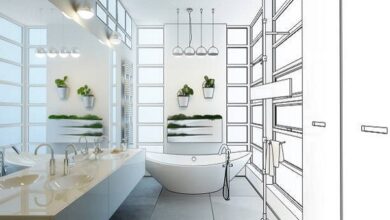The Ultimate Guide to Bathroom Remodeling: Design, Budget, and Timeline
Bathroom Remodeling

Bathroom remodeling is an exciting and transformative home improvement project that can enhance both the functionality and aesthetics of your space. Whether you’re looking to update an outdated bathroom, create a luxurious spa retreat, or add value to your home, a well-planned renovation can make a significant difference. In this ultimate guide to bathroom remodeling, we’ll explore the key elements of the process, from designing your dream bathroom to setting a budget and managing the timeline effectively.
-
Designing Your Dream Bathroom
- Assessing Your Needs: Before diving into the design phase, evaluate your needs and preferences. Consider how many people will use the bathroom, the storage requirements, and any accessibility considerations. Identify the fixtures and features you want to include, such as a bathtub, shower, vanity, or a larger mirror.
- Style and Theme: Choose a style and theme that aligns with your overall home decor. Whether you prefer a modern, contemporary, traditional, or eclectic look, cohesive design elements will create a harmonious and inviting space.
- Layout: The layout of your bathroom is crucial for optimizing space and flow. If possible, try to maintain the existing plumbing configuration, as relocating pipes can add significant costs to the project. However, if the current layout doesn’t suit your needs, work with a professional designer to create a functional and efficient layout.
- Lighting and Ventilation: Adequate lighting and ventilation are essential for a functional bathroom. Incorporate both natural and artificial lighting to create a well-lit and inviting atmosphere. Proper ventilation helps prevent moisture-related issues, such as mold and mildew.
-
Setting a Realistic Budget
- Research and Prioritize: Conduct thorough research to understand the average costs of materials, fixtures, and labor in your area. Create a prioritized list of must-haves and nice-to-haves to allocate your budget effectively.
- Contingency Fund: It’s essential to set aside a contingency fund of around 10-20% of your total budget to account for any unforeseen expenses or changes during the remodeling process.
- DIY vs. Professional Help: While DIY projects can save money, bathroom renovations often require expertise in plumbing, electrical work, and tile installation. Determine which tasks you can handle yourself and where professional help is necessary.
- Phased Remodeling: If your budget is limited, consider breaking the project into phases. Focus on essential upgrades first and tackle non-urgent improvements later when finances permit.
-
Managing the Timeline
- Project Schedule: Work with your chosen contractor to develop a detailed project schedule. Understand the order of tasks and the estimated time for completion. A well-structured timeline helps keep the project on track and minimizes disruptions to your daily life.
- Order of Tasks: In general, bathroom remodeling tasks follow a sequence: demolition, plumbing and electrical work, installation of fixtures, tiling, painting, and finishing touches. Proper planning of the order of tasks ensures a smooth and efficient remodeling process.
- Lead Times: Keep in mind that some fixtures or materials may have longer lead times for delivery. Plan ahead and order these items early to avoid delays in the project.
- Communicate with Your Contractor: Maintain open communication with your contractor throughout the remodeling process. Regular updates and discussions about any potential delays or changes will help you stay informed and avoid misunderstandings. Choosing the right bathroom remodeler is essential for a successful your project.
-
Sustainable and Eco-Friendly Choices
A. Water-efficient Fixtures: Opt for water-saving toilets, faucets, and showerheads to reduce water consumption and lower utility bills.
B. Energy-efficient Lighting: Choose LED or CFL bulbs for energy-efficient lighting solutions that last longer and consume less electricity.
C. Eco-Friendly Materials: Consider using eco-friendly and sustainable materials such as bamboo, recycled glass, or reclaimed wood for your bathroom renovation. These choices contribute to a greener and more environmentally responsible project.
Conclusion
Bathroom remodeling can be a rewarding endeavor, adding value to your home and elevating your daily living experience. By following this ultimate guide, you can design your dream bathroom, set a realistic budget, and manage the project timeline effectively. Whether you decide to embark on a DIY journey or hire a professional contractor, careful planning and thoughtful decision-making will ensure a successful and satisfying bathroom renovation. Enjoy the process and revel in the transformation of your bathroom into a beautiful, functional, and inviting space.



